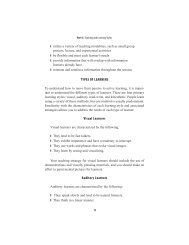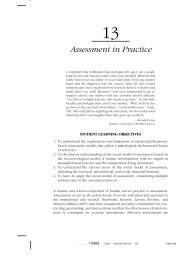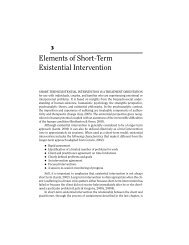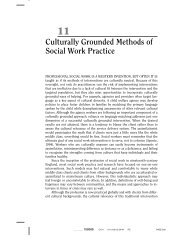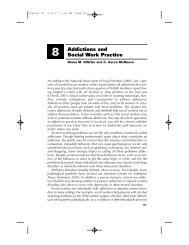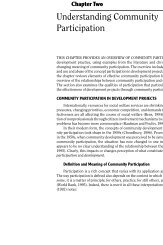Social Work's Historical Relationship to Volunteerism - Lyceum Books
Social Work's Historical Relationship to Volunteerism - Lyceum Books
Social Work's Historical Relationship to Volunteerism - Lyceum Books
You also want an ePaper? Increase the reach of your titles
YUMPU automatically turns print PDFs into web optimized ePapers that Google loves.
Chapter 5 <strong>Social</strong> Work’s <strong>His<strong>to</strong>rical</strong> <strong>Relationship</strong> <strong>to</strong> <strong>Volunteerism</strong> 73<br />
recognized social work’s fascination with psychiatry, psychotherapy, and the<br />
medical-model approach <strong>to</strong> practice. While acknowledging their professional benefits,<br />
she tried reminding her colleagues of the importance of working with volunteers.<br />
Speaking <strong>to</strong> her colleagues, she posited the following request: “I should like<br />
now <strong>to</strong> ask a favor of the psychiatric social workers. They are the newest and most<br />
popular group among us. They are taking great care of the individual who is brought<br />
<strong>to</strong> them, whether he comes as a free nursery child, or whether he comes from the<br />
courts. Perhaps we can ask them that they go outside of this individual analysis and<br />
give us a little social psychiatric work” (Addams, 1926, p. 7). She then reminded<br />
them that, from a clearly ethical point of view, social work must always involve partnering<br />
with people in the community who are closest <strong>to</strong> the poor and are living as<br />
best they can.<br />
It appears very few social workers listened <strong>to</strong> Addams. In fact, a few years later,<br />
in a famous address <strong>to</strong> the 1929 National Conference of <strong>Social</strong> Work, Porter Lee<br />
(1937), direc<strong>to</strong>r of the New York School of Philanthropy, declared that training volunteers<br />
<strong>to</strong> lead and participate in social movements was no longer a function of social<br />
work. Instead, he suggested that social work’s primary function was serving individuals<br />
through the use of primarily methods based on psychiatric and other<br />
psychotherapeutic interventions. His views represented the dominant position in<br />
the field. A quick glance at current employment trends indicate that his views are<br />
held by the majority of social workers <strong>to</strong>day. <strong>Social</strong> workers are most likely <strong>to</strong> work<br />
in direct clinical roles that generally do not involve work with volunteers (U.S. Department<br />
of Labor, 2006).<br />
The profession as a whole continues <strong>to</strong> avoid social work practice with volunteers<br />
and <strong>to</strong> ignore both calls for more practice with volunteers and scholarship<br />
demonstrating the value of volunteers <strong>to</strong> the social work profession. Theilen and<br />
Poole (1986) have argued that volunteer associations are one of the most effective<br />
yet frequently overlooked avenues that social workers have <strong>to</strong> achieve social<br />
change. They suggest that social work educa<strong>to</strong>rs need <strong>to</strong> cover content on volunteerism<br />
throughout the entire curriculum. Other scholars have suggested that<br />
the profession’s emphasis on facilitating transactions between the person and the<br />
environment makes social workers well suited <strong>to</strong> educate, support, and partner<br />
with volunteers <strong>to</strong> develop and implement effective services (Anderson & Ambrosino,<br />
1992; Euster, 1984; Forte, 1997; Sherr & Straughan, 2005). Moreover, a<br />
few social work scholars, such as Ram Cnaan and Robert Wineburg, have spent<br />
their careers teaching students <strong>to</strong> practice with volunteers. Both have published<br />
numerous articles and books imploring the social work community <strong>to</strong> appreciate<br />
the possibilities of working with volunteers. Considering the concerted bipartisan<br />
efforts <strong>to</strong> encourage more volunteerism and localize social welfare services,<br />
Wineburg (2001) laments that the social work community has “virtually ignored<br />
one of the most important changes <strong>to</strong> hit local human services systems in many<br />
years” (p. 37).





